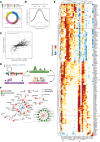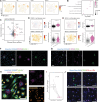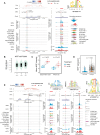A Novel Macrophage Subpopulation Conveys Increased Genetic Risk of Coronary Artery Disease
- PMID: 38747151
- PMCID: PMC11191562
- DOI: 10.1161/CIRCRESAHA.123.324172
A Novel Macrophage Subpopulation Conveys Increased Genetic Risk of Coronary Artery Disease
Abstract
Background: Coronary artery disease (CAD), the leading cause of death worldwide, is influenced by both environmental and genetic factors. Although over 250 genetic risk loci have been identified through genome-wide association studies, the specific causal variants and their regulatory mechanisms are still largely unknown, particularly in disease-relevant cell types such as macrophages.
Methods: We utilized single-cell RNA-seq and single-cell multiomics approaches in primary human monocyte-derived macrophages to explore the transcriptional regulatory network involved in a critical pathogenic event of coronary atherosclerosis-the formation of lipid-laden foam cells. The relative genetic contribution to CAD was assessed by partitioning disease heritability across different macrophage subpopulations. Meta-analysis of single-cell RNA-seq data sets from 38 human atherosclerotic samples was conducted to provide high-resolution cross-referencing to macrophage subpopulations in vivo.
Results: We identified 18 782 cis-regulatory elements by jointly profiling the gene expression and chromatin accessibility of >5000 macrophages. Integration with CAD genome-wide association study data prioritized 121 CAD-related genetic variants and 56 candidate causal genes. We showed that CAD heritability was not uniformly distributed and was particularly enriched in the gene programs of a novel CD52-hi lipid-handling macrophage subpopulation. These CD52-hi macrophages displayed significantly less lipoprotein accumulation and were also found in human atherosclerotic plaques. We investigated the cis-regulatory effect of a risk variant rs10488763 on FDX1, implicating the recruitment of AP-1 and C/EBP-β in the causal mechanisms at this locus.
Conclusions: Our results provide genetic evidence of the divergent roles of macrophage subsets in atherogenesis and highlight lipid-handling macrophages as a key subpopulation through which genetic variants operate to influence disease. These findings provide an unbiased framework for functional fine-mapping of genome-wide association study results using single-cell multiomics and offer new insights into the genotype-environment interactions underlying atherosclerotic disease.
Keywords: atherosclerosis; cholesterol, LDL; coronary artery disease; genome-wide association study; macrophages; multiomics; single cell analysis.
Conflict of interest statement
Figures







References
-
- Kassebaum NJ, Bertozzi-Villa A, Coggeshall MS, Shackelford KA, Steiner C, Heuton KR, Gonzalez-Medina D, Barber R, Huynh C, Dicker D, et al. . Global, regional, and national levels and causes of maternal mortality during 1990-2013: a systematic analysis for the Global Burden of Disease Study 2013. Lancet. 2014;384:980–1004. doi: 10.1016/S0140-6736(14)60696-6 - PMC - PubMed
-
- Malakar AK, Choudhury D, Halder B, Paul P, Uddin A, Chakraborty S. A review on coronary artery disease, its risk factors, and therapeutics. J Cell Physiol. 2019;234:16812–16823. doi: 10.1002/jcp.28350 - PubMed
-
- Chinetti-Gbaguidi G, Colin S, Staels B. Macrophage subsets in atherosclerosis. Nat Rev Cardiol. 2015;12:10–17. doi: 10.1038/nrcardio.2014.173 - PubMed
MeSH terms
Grants and funding
LinkOut - more resources
Full Text Sources
Medical
Miscellaneous

